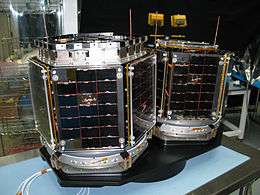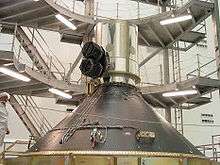3 Corner Satellite
 Two 3CS satellites undergoing testing | |
| Country of origin | United States |
|---|---|
| Operator | CU-Boulder, ASU, NMSU, AFRL, STP |
| Applications | Technology demonstration |
| Specifications | |
| Design life | 2-4 months[1] |
| Regime | Low Earth (planned) |
| Production | |
| Status | Failed |
| Built | 3 |
| Launched | 2 |
| Lost | 2 |
| First launch |
Ralphie/Sparkie December 21, 2004 Failed to orbit |
Three Corner Satellite (or 3CS, or 3CornerSat) consists of three student-built microsatellites flying in formation. Primary mission objectives were to demonstrate formation flying, provide stereoscopic imaging of cloud formations, and demonstrate distributed and autonomous operations.[2]
A pair of spacecraft, Ralphie and Sparkie, was developed by the University of Colorado at Boulder and Arizona State University as part of the Air Force Research Laboratory's University Nanosat Program.[3] A third satellite, Petey, developed by New Mexico State University was originally also part of the 3CS but was not completed in time for launch.
The 3CS stack was originally slated for launch aboard the Space Shuttle in 2003, but after Shuttle Columbia tragedy, mission organizers switched to Boeing Delta IV Heavy rocket (it was its first launch). Due to a problem with the rocket during launch, 3CS failed to achieve orbit.[4] Satellites were to have been dropped off at a low 180 km × 240 km, but they entered orbit at a height of only 105 km, which led to a rapid decay.

Project's mission
Primary mission objectives:[5]
- stereoscopic imaging of clouds and other atmospheric structures
- formation flying - the satellites will operate as a network to synchronize targeting and data acquisition and to relay health and status information among the satellites in the constellation
- End-to-End Data Systems (EEDS) will support automated operations, react to unplanned faults and opportunities, and to optimize operations and data handling
Secondary mission objectives:
- demonstrate micro propulsion, by increasing the satellites' altitude to extend mission lifetime and improve data gathering capacity
- demonstrate a modular spacecraft bus design
- emphasize student education by allowing students to actively participate in program
The spacecraft were equipped with robust execution management software (Spacecraft Command Language (SCL), Continuous Activity Scheduling Planning Execution and Replanning (CASPER) software, Context-sensitive anomaly detection software (SELMON monitoring system)
References
- ↑ NASA Jet Propulsion Laboratory. "Three Corner Satellite". Retrieved 2009-01-17.
- ↑ Stephen Levin-Stankevich. "Commanding and Safeguarding The Three Corner Satellite Constellation". University of Colorado at Boulder. Retrieved 2011-02-18.
- ↑ Boeing (2004-12-01). "The DemoSat payload". Spaceflight Now. Retrieved 2008-08-02.
- ↑ Ray, Justin (2005-03-15). "Delta 4-Heavy investigation identifies rocket's problem". Archived from the original on 29 August 2008. Retrieved 2008-08-02.
- ↑ "3CSat 1, 2, 3 (Nanosat 2)". Retrieved 2011-02-22.
External links
- NASA's Three Corner Satellite Project Homepage
- http://ase.jpl.nasa.gov/public/projects/3cs/
- http://spacegrant.colorado.edu/3cs/